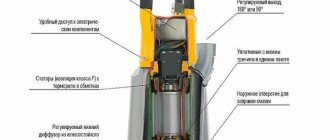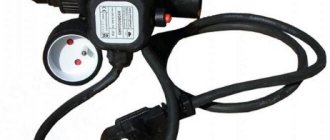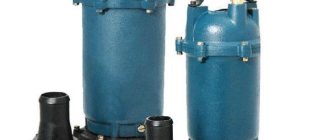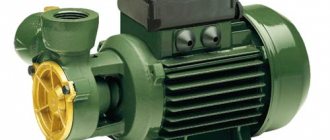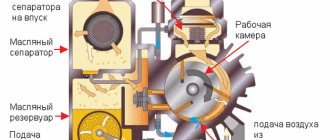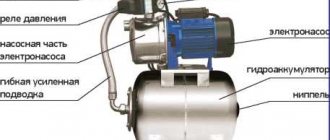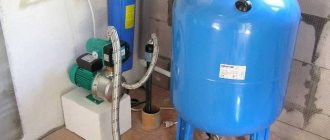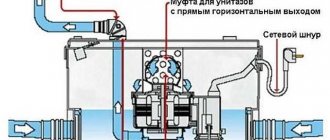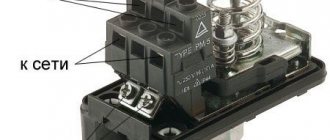The drainage system is an important component of comfortable living in a private house and apartment. Unfortunately, it is not always possible to arrange a drain so that liquid flows out of the home on its own. In this case, you will need to use a sewer pump. This unit is very easy to install under the sink or in the bathroom, it does not consume a large amount of energy and operates almost silently.
Types of fecal devices
All sewage pumps are divided into several categories based on their technical characteristics. So, based on their design features, they are divided into the following groups:
- drainage type (pumps clean and slightly contaminated water);
- fecal type (pumping out feces, sewage, and highly contaminated water);
- sewerage pumping stations (discharge sewage in automatic mode).
Any fecal device is equipped with level sensors, and therefore they are divided into:
- pumps with float switch. This type is equipped with a simple electric key, the work of which is to close or open the system. It all depends on the position of the float;
- pumps with touch sensor. They are a two-sensor device, where one sensor is located at the base of the pump, the other in the area of the top cover. This system is very simple. As soon as the liquid exceeds the upper sensor level, the upper sensor is triggered and the engine starts. As soon as the liquid reaches the lower level of the sensor, the lower sensor turns off the motor.
Sewage pumps are further divided into the following types:
- submersible and semi-submersible plan;
- external plan, which are adapted for pumping cold liquids;
- external plan, which are able to pump hot wastewater with a maximum temperature of up to 90 degrees.
There is also another division of pumps into the following subtypes:
- by distinction related to appointment;
- differ in characteristics (power, productivity, pressure);
- can be mobile or stationary;
- oil or water engine cooling system;
- with horizontal or vertical connection method.
Types of structures
Only then will forced sewerage in a private house work for a long time without failures; when organizing it, you need to choose a reliable pump. All of them are divided into several types. We describe their main properties and distinctive features in the following table.
| Pump type for forced sewerage | Characteristics of the type of sewage pumps | Maximum sewer temperature |
| Models without grinding element, suitable for cold wastewater | The cost of such units is the lowest. Intended for swimming pools, as well as basements that are flooded during spring floods. | No higher than 40? |
| Units without grinding element used for hot waste water | They cope well with pumping water without solid particles, which is typical for baths or saunas. | Not higher than 90? |
| Models with a grinding device, suitable for cold domestic wastewater | They are most popular among consumers, as they effectively pump out all the sewage from the toilet, crushing hairs, hygiene products, and the like into small particles. | No more than 40? |
| Units with a grinding element used for hot wastewater | Their design is similar to models with a shredder, but they are capable of raising high-temperature wastewater. Purchased for baths with toilet. | Up to 90? |
Grinder pump for forced sewerage
With chopper
Without chopper
Forced
Purpose of sewage pumps
Fecal pumps are manufactured to perform the following functions:
- they are installed in rooms whose level is below the sewer drain (in basements, basements);
- you can connect several household appliances to them at once;
- facilitates rearrangement of the sink;
- prevents sewer pipes from becoming clogged, and therefore there is no possibility of plugging.
Installation of sewerage equipment
Both the plumbing pump for the toilet and the equipment for the kitchen need to be installed correctly. Their proper operation for many years depends on the correct installation of sewer pumps. Let's look at the installation of the device using the example of installing a device for servicing a sink. This must be done in several stages:
- First you need to unscrew the pipe or drain hose from the sink;
- Next, at the sink you will need to fix the mounting fasteners included with the device;
- After this, you need to connect the pipes from the sink to the body of the unit;
- On the other side, the device is connected to the sewer;
- Finally, all that remains is to connect the device to the power supply.
Experts advise using only propylene pipes to connect the pump to the sewer. If entire pumping stations for sewage are installed, then the pipes must be of a fairly large diameter. It is prohibited to connect several pumps to one pipe at once, as this will lead to inevitable repairs of the pipeline. When installing a pump for a shower cabin, you should ensure that it is securely fastened.
When using a sewage pump, you must ensure that it is not used for pumping hot water.
How do sewer pumps work?
The operating principle is quite simple. The drain liquid, together with waste products, enters the tank. As soon as the amount of this liquid reaches a set level, a mechanism for forced pumping is activated using a float. The shredder is immediately activated, thanks to which large pieces of waste are crushed.
It is worth noting that the operation of the sewage pump prevents the appearance of unpleasant odors in the room. This is due to the fact that the pump is equipped with a sealed housing, a check valve and a carbon filter.
The system does not require additional maintenance. You just need to flush the tank regularly. There are some nuances that are associated with the operation of pumps. Due to the fact that such devices operate from the network, they require uninterrupted power supply. Otherwise, their operation is not possible.
Criterias of choice
When purchasing equipment, you need to pay attention to the following parameters:
- The voltage in the network should be 220 V. For a three-phase network - 380 V. In extreme cases, it is necessary to install a voltage stabilizer, since not all equipment can withstand surges and may break.
- The height of the water column to overcome vertical and horizontal sections of the highway.
- For submersible equipment, the distance from the body to the water surface is important. For semi-submersible or surface – the maximum depth of the hose.
- Pump performance is the amount of liquid that it is capable of pumping per unit of time. Equipment with a power of up to 400 W pumps about 100 liters of water per minute, a 1 kW pump - 200 - 300 liters.
- Estimated size of large particles.
- The presence of several levels of protection against dry running - the float mechanism is most often used. The check valve prevents liquid from draining into the drainage pit when the engine is turned off. The degree of protection of the housing against moisture must be at least 68 units according to the IP system.
- The degree of aggressiveness of the pumped liquid is taken into account. Acid-based detergents, which can damage low-quality materials, as well as hot water, fall into the waste pit.
Ease of installation and carrying is also taken into account - handles, attachment of sleeves or pipes. Preference should be given to well-established companies that have been operating on the Russian market for a long time, because they last a long time and require less costs during operation.
Advantages and disadvantages of sewerage stations
Sewage stations have the following advantages:
- low noise level;
- versatility;
- compactness;
- ease of installation and subsequent maintenance;
- fairly good external data.
Such stations can be used for quite a long time thanks to the chopper. This device helps to make not only feces very small, but also other items that enter the system: toilet paper, hygiene products. There is an opinion that it is almost impossible to clog such a system.
Today, manufacturing companies produce two types of sewage pumps: special and for general use. Special ones are installed for certain places, such as the kitchen and toilet, then the two points are connected together and a pump is installed there to discharge the wastewater. The second type is used wherever it is necessary to pump out sewage and wastewater.
Installation stages
The equipment is most often installed behind the toilet, in the kitchen and in the sewer. Before installing sewage pumps yourself, you must read the instructions several times.
The submersible pump may have feet that are attached to a concrete base. Such models are usually installed before they begin to use the sewer system. If the need for installation arose during the operation of the septic tank, the unit is weighed down and lowered to the bottom of the pit. The ropes must be strong; it is better to use nylon or stainless steel chain.
For kitchen or toilet pumps, it is important that the size of the inlet and outlet pipes match. It is not difficult to install these units according to the instructions.
Pros and cons of sewage pumps
Basically, these devices have only positive qualities, namely:
- high performance at an affordable price (a unique combination of price and quality);
- models are equipped with a filter that prevents solid particles from entering directly into the pump, thereby protecting it;
- can work both with full and partial immersion;
- small size, low noise level;
- Installs quickly and easily.
The only drawback is considered to be that this type of pump can lift water from a depth not exceeding 10 meters. It is also not recommended to install it in close proximity to a silty or sandy bottom.
Flaws
- Despite the fact that a sanitary pump is more economical than laying a new standard (gravity) type sewer, the cost of such equipment is quite high.
- If there are several places for drainage in the house, then you will have to buy not one device, but several.
- If there is no electricity, the pump will not work.
- A pump for a forced sewer system will consume additional electricity, which increases costs.
- When installed in the kitchen, regular maintenance is required, as fatty masses accumulate in the body.
- If any foreign object gets into the sanitary pump, the device may fail or clog the system. Let’s say a rag that falls into the toilet will definitely not be recycled, and the sediment will require repair. A metal object can cause irreparable damage, and the only solution is to replace the device.
If you are not yet familiar with my colleague’s article on water pipe freezing and the main ways to prevent it , then you can read it at this link.
I hope my article was useful to you. Now you know what a sanitary pump is, how to install it and, most importantly, you will be aware of the advantages and disadvantages of such equipment. If you use this device, please write down your impressions of its use and what problems you encountered.
Borehole pumps, their advantages and disadvantages
- The positive points include:
- they have a small diameter, which makes it possible to use it for pumping water from narrow wells;
- able to lift water from a depth of 50 meters;
- will work well near sandy, muddy or calcareous bottoms;
- it is perfectly protected from overheating and power surges;
- copies are produced that can be installed in a horizontal position.
There is one significant drawback. These categories of pumps are very difficult to repair. In order to troubleshoot a device, you must first remove it, repair it, and then install it again. But, despite this, the pump is able to operate without failure for quite a long time and its performance is very high.
Parameters influencing the choice of a bathroom pump
Modern manufacturers offer users several different modifications of bathroom pumps, which differ in technical characteristics and are designed to perform specific tasks. The key parameters that influence the choice of device include:
- unit power;
- number of connected plumbing fixtures;
- maximum wastewater temperature;
- water pressure;
- performance;
- type of waste processed: biological waste, hair, fecal matter, waste from washing clothes.
All of the above factors must be taken into account when choosing a pump. If you ignore at least one of them, you can end up with a poorly functioning system and problems with water drainage.
You need to select a pump strictly on an individual basis, based on financial capabilities, personal needs and room layout. Despite similar technical characteristics, each pump has its own capabilities. Therefore, before installing it in the bathroom, you need to determine what and in what quantity will be installed with it. That is, will this pump be connected to the toilet, which means whether it is necessary to crush fecal waste, what water temperature it can withstand, and what volume of wastewater it can pump.
Scope of application of sewage pumps
Their scope of application is very diverse. Such devices are often found both in industrial enterprises and in the private sector. Thanks to them, dirty liquids containing solid particles are pumped. Household models are able to handle from 5 to 25 cubic meters/hour. Domestic installations are used mainly to pump out wastewater in a storm drain or an autonomous system, surface water from basements and basements, well water, and drain pools, ponds and natural reservoirs. But pumping water is not their only purpose. They can be used for large reservoirs to circulate water, as well as for irrigation of land.
Types of pumps for pumping out wastewater
First of all, you need to decide which of the types of sewer pumps that exist today should be chosen for a private home. Let's describe each of them in more detail.
Today, all models of sewerage pumps in an apartment or house are divided into two types. The choice of one of them should be determined by the degree of pollution of the wastewater:
- drainage – suitable for pumping out water if a basement, cellar, swimming pool, or sump is filled with water. That is, for those places where there is exceptionally dirty water coming out of washing or dishwashing equipment without solid particles;
- fecal - can be used not only for dirty water, but also for feces, as well as liquids with solid inclusions, with a diameter of 42 to 80 mm. They are characterized by larger flow channels. In addition, we note that such units have an additional device for the complete grinding of large-sized household waste. They easily handle solid waste due to the presence of an impeller with a round knife or cutting edge located in it.
Drainage pump
Sewage pump
The mentioned types of such equipment are often confused with each other, however, their design has significant differences. And they consist precisely in the presence of a grinding mechanism for the drive shaft in fecal models.
Device and purpose
Sewage pumps consist of a small volume container and a built-in motor that moves wastewater. Liquid moves horizontally and vertically. The equipment can be with or without a cutting element.
Application area
The device is often used when plumbing fixtures are installed below the drain hole. For this purpose, special pumps have been developed, thanks to which bathrooms can be moved to the basement. The device is suitable for installation after repair work and in cases where the system is not connected to the installation site of plumbing equipment. In such a situation, the plumbing fixtures are connected to a small pump, and the pump is connected to the drain.
Installing the device at home differs from installing a gravity sewer:
- pipes can be routed horizontally up to 100 m with a slope of at least 1-4%;
- pipeline diameter is 28-40 mm;
- The drain can be raised up to 9 m.
On the left is a diagram of the operation of a submersible pump, on the right is the general structure of a plumbing pump for sewerage.
Design and principle of operation
The components of the device are a container and a motor. Some options are equipped with a grinder and are used for the toilet. To monitor the filling level, a special sensor is installed in the device. The waste flows into the sewer after it is turned on. Then the pump and chopper are connected. The device turns off after a signal from another sensor when the wastewater falls below the set level. This is how pressure sewer works.
A different number of different devices can be connected to pumping stations. Some are connected to 1-2 devices, and the most productive include stations with a main and 3 additional pipes. The container may have several inlets and one outlet.
Inputs are used to connect plumbing fixtures, and the outlet is mounted to the drain. Models made of heat-resistant materials are suitable for high-temperature waste liquid. They are able to cope with high temperature loads.
KNS service
Maintenance of a sewage pumping station is a series of specialized activities that help maintain the system in good condition.
In order to ensure the operability of all station mechanisms, constant monitoring of routine maintenance servicing the control and warning system, pipelines, and sensors is necessary.
Compliance with all rules for using equipment will reduce the risk to a minimum level, which in turn will have a beneficial effect on operation.
When to use the pump
A sewerage pumping unit is needed to remove wastewater under pressure. It is used in systems located below the level of the collector. Such situations arise if the building is located in a low-lying area, on a difficult terrain, or when wastewater is transferred through any structures. For example, when a line crosses a highway and horizontal drilling is not possible. We have to make a vertical portal that goes around the road surface from above. The supply of wastewater through a vertical pipeline is possible using special equipment - a mud pump.
The basic design of drainage systems is based on the independent movement of wastewater under the influence of gravity. Gravity networks are cheap and do not require the use of electrical appliances. However, for them to work, it is necessary to ensure a height difference between the starting and ending points. This is not always possible; terrain features, previously laid communications or other obstacles interfere. Installing a sewage pump allows you to organize the supply of wastewater under pressure to a reservoir located at the highest point, from where the liquid can move by gravity.
Installation of a sewage pump is necessary in the following cases:
- location of the house in a lowland, fold of the relief;
- the need to transfer wastewater from the basement or from areas located lower than the street drainage network;
- bypassing highways, exclusion zones of electrical cables or communication wires, gas communications;
- tracing a line on a hillside, the need to raise drains to a higher point;
- drainage from industrial installations or stormwater systems.
In addition to these cases, pumping stations are often used to remove wastewater from apartments where reconstruction, redevelopment or repairs are being carried out. In addition, the pump is often used in premises where the installation of sewerage was carried out with errors and violations of technology. This requires the installation of pressure pipes that can withstand the operating pressure of the pump. The operating principle of the sewerage installation is to increase the pressure in the pipeline. Drains are able to move inside a vertical or inclined pipe in the direction from the lowest point to the highest. To avoid blockages in the pressure pipe, some models are equipped with shredders. They grind large inclusions, organic matter or foreign objects, creating a homogeneous suspension.
How to choose pumping equipment
To choose a pump, you need to take into account its characteristics.
Maximum head and lift height
The distance over which the pump lifts the wastewater depends on the pressure indicator. It must be taken into account that there are vertically and horizontally located pipe sections. To calculate the parameter, the horizontal distance indicator is divided by 10 and added to the vertical footage from the edge of the container to the pump. The result should be 20-25% less than what is indicated in the documents for the equipment.
You should also consider:
- pipe diameter;
- speed of fluid movement;
- temperature and components of sewage waste;
- pressure;
- pipeline material and other factors.
If you do not have knowledge in the field of arranging a sewer system, then you can get advice from a specialist or purchase a device with a reserve of power and pressure so that it works for a long time.
Working temperature
The equipment is divided into the following groups:
- for hot water (up to +90°C);
- for cold wastewater (up to +45°C).
When only cold liquid enters the sewer, the second option is suitable. The device is most often installed in country houses. Boiling liquid enters the sewer during an emergency discharge from the heating system.
Submersible pump housings are made of both plastic and stainless steel.
Availability of automation
It is difficult to operate a sewage pump manually because you need to be near the equipment to do this.
To simplify the operation of the device, the following may be included with it:
- thermal relay designed to turn off at high temperatures;
- float that starts and turns off the device.
The risk of clogging equipment with a chopper is reduced by self-cleaning of its cutting element, if the manufacturer provides this function. It increases the time the pump can be used without stopping. Thanks to self-cleaning, the likelihood of overheating of the device is reduced.
Power supply and housing material
Connecting to a single-phase power supply allows you to power the pump through a stabilizer or to a portable generator during power surges. For three-phase equipment to operate, a control panel is required. This will protect the device from phase imbalances in the electrical network.
A household model with a metal body is reliable for a private home. The plastic analogue is affordable, but with aggressive exposure its service life is reduced. There is an option with a plastic body and metal working parts.
When choosing a pump, you need to take into account the expected load on the device. To install a sewer system in a house with seasonal residence, they buy a low-power submersible device or a surface device.
